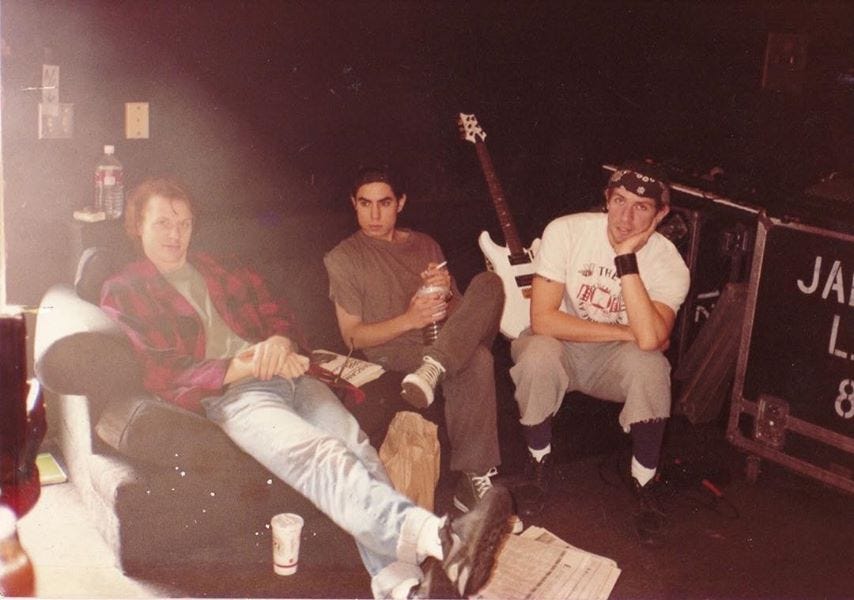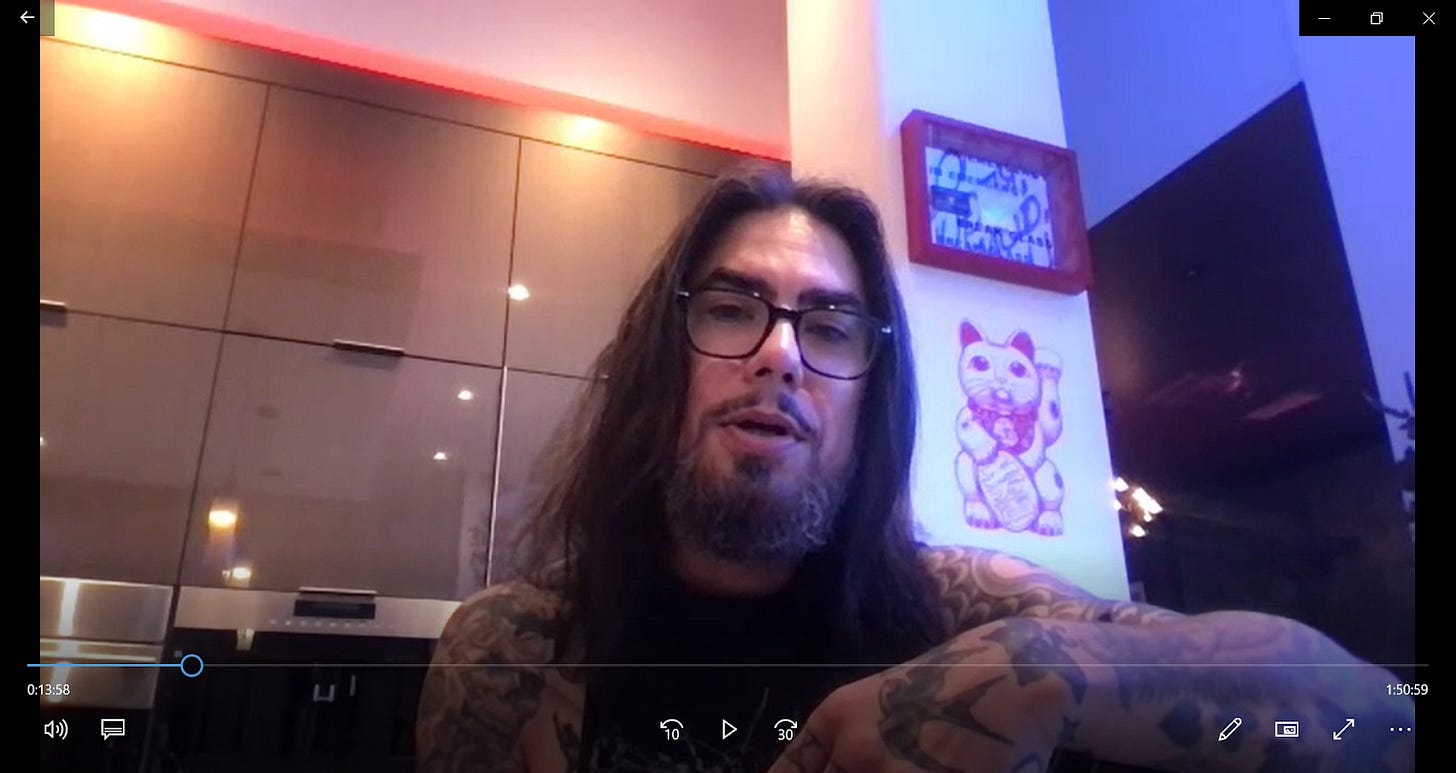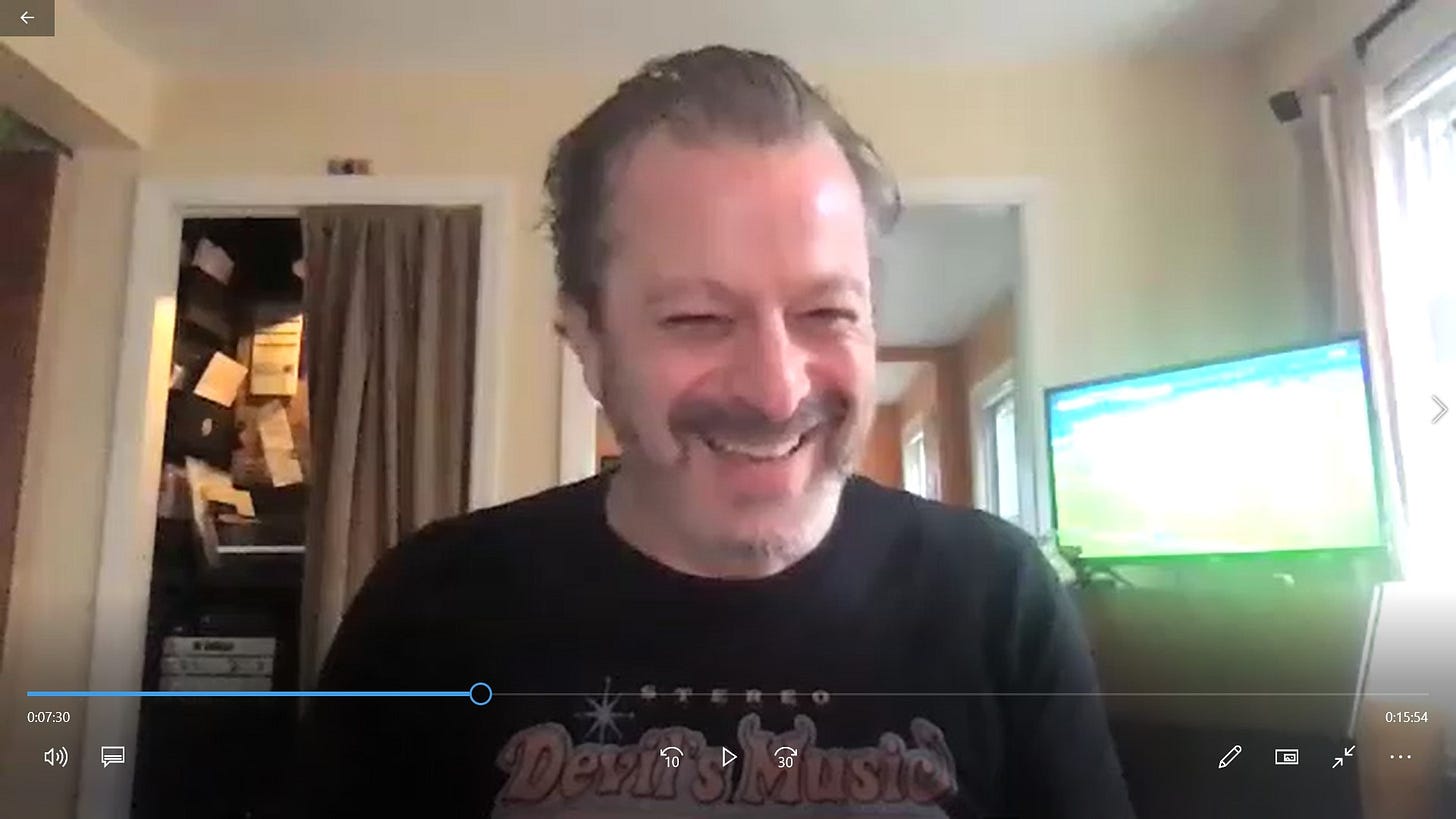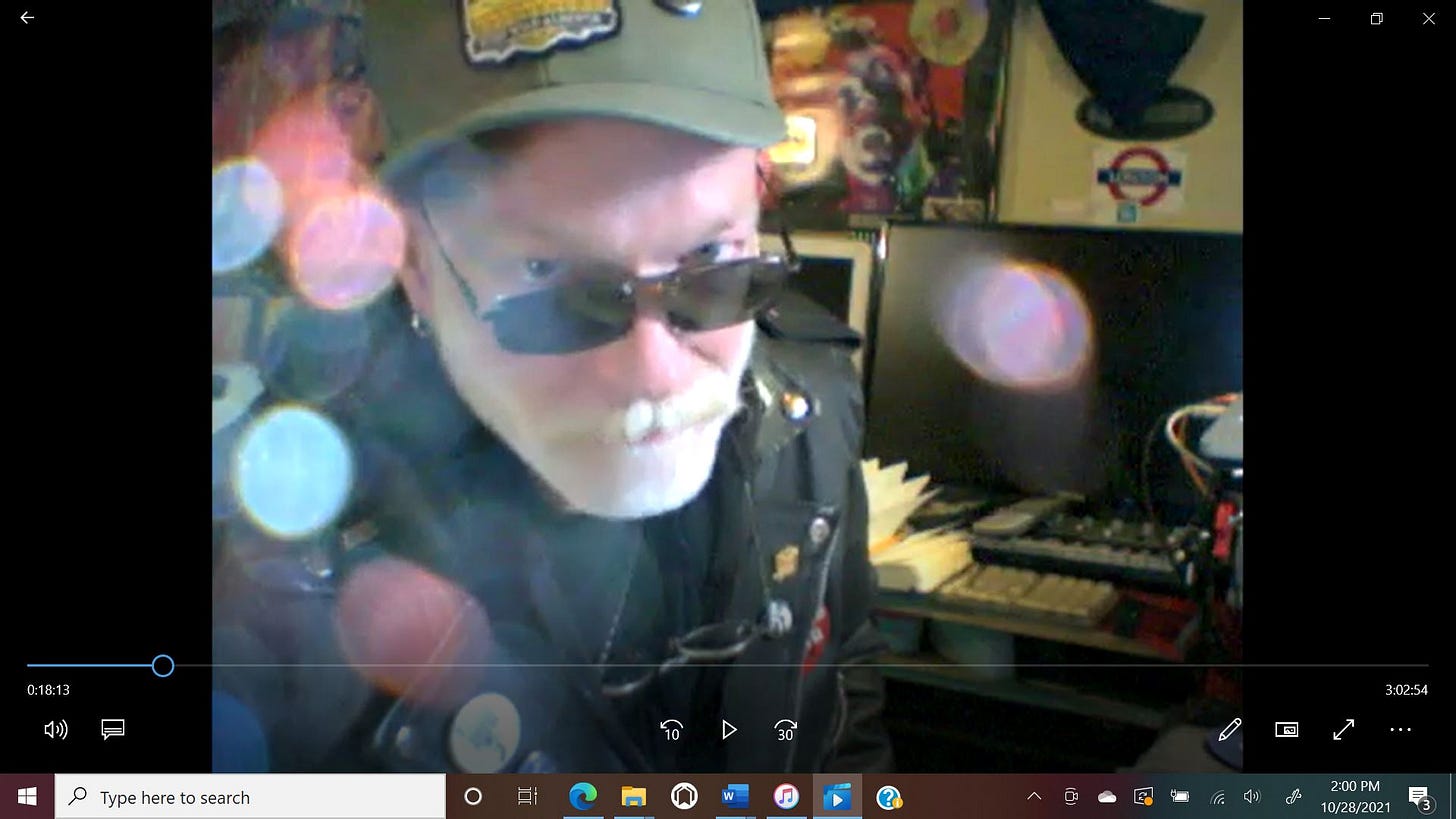Introduction: A whole music series about an album that came out in 1994 by a band who never performed or recorded again?
Absolutely
This is the only in-depth story about the short-lived band Deconstruction. Somehow it took 27 years for someone to write it. I didn’t expect it would be me.
Jane’s Addiction bassist Eric Avery and guitarist Dave Navarro formed Deconstruction in late-1992, not long after Jane’s broke up, and they released only one album, Deconstruction, right after they broke up, too. For many of us ’90s kids, Jane’s Addiction was our Velvet Underground. And like the Velvet Underground, they formed as a democracy but came apart around an ambitious, creative lead singer’s control. When I bought Deconstruction in 1995, I instantly loved it. I was a hardcore Jane’s fan. Four years had passed since I’d seen Jane’s play on their final tour in 1991, and although Deconstruction didn’t sound like Jane’s, and Avery didn’t sing like Perry Farrell, the band was just as powerful. Ritual de lo Habitual has nine songs and changed rock music forever. Deconstruction has 15 songs and is equally dynamic, effecting, unique, and it has equally powerful guitar.
As a college student, I regularly blasted Deconstruction at ear-destroying levels. The neighbors on the other side of my crummy apartments’ cinder block wall must have hated me. “L.A. Song,” “Single,” “Get At ’Em,” “Kilo,” and “Iris” were my jams. My car stereo speakers rattled as I played them on drives. My ears hurt while listening to them on my Sony Discman, walking to class. The first time I heard this album, it had that rare magical quality that Joy Division has. The whole album was powerful, but I played the instrumental “Iris” the most. I wished “Iris” was longer. I wished other songs sounded like it. My neighbors probably wished I would move. But that was part of the album’s beauty: No two songs sounded the same.
Musically, Deconstruction was so left-field that it felt fresh and out of step with the tired alternative rock formula that dominated the so-called ’90s Alternative Era. By 1995, I was tired of Billy Corgan’s whining voice, tired of all the bad Eddie Vedder impressions, tired of the sound of Oasis’ Gallagher brothers talking. Sure, I was excited to hear anything any Jane’s guys were doing, but Deconstruction’s song structures, and the interplay between Navarro’s and Avery’s instruments, made the album so unusual that they should have been the talk of the ’90s. Instead, there was little talk about them at all.
Deconstruction had no MTV coverage. They had no big profiles in music magazines like Spin, no radio play or late-night TV appearances on Conan O’Brian or David Letterman, or slots on Lollapalooza’s second stage. Despite one fleeting announcement and one long review in Rolling Stone, the album arrived so quietly that it only existed through word-of-mouth, which made the CD in your hand seem a precious thing, something you would have missed had you turned your head at the wrong moment. Un-hyped and unpromoted, the band was underground in a way that the popular, influential Jane’s Addiction could no longer be. Maybe they wanted it that way. In a world before the internet, news traveled differently, so Deconstruction became a secret rock ‘n’ roll handshake, a musical gift you gave to other adventurous listeners, and eventually, a mysterious artifact of its time.
In 1995 I waited for Deconstruction’s name to appear in my local weekly’s concert listings. It never did. Jane’s reunited in 1997 without cofounder Eric Avery. Time passed. The ’90s ended. Deconstruction never toured. My tastes changed and Deconstruction got pushed to the back of my CD collection, pinned behind mid-century jazz and vintage Blues with all the ’90s bands I rarely listened to anymore, and mp3s replaced CDs. Years later, I found my CD in a box in my basement. And when I played it, it slayed me as much as it had on first listen.
Many fans consider Deconstruction to be the best thing any member of Jane’s Addiction did after Jane’s. Many consider it proof of Avery’s genius. Many think it contains the best guitar Navarro ever played. In 2021, it still sounds potent enough to make those cases.
When I tried to learn about the band’s story, I found very little information. There was one short band interview archived online, conducted right after they broke up. And there were a bunch of small quotes and tantalizing details collected on a janky fan site that looked like it hadn’t changed since 1997, and thank the stars for the fans who created it. Besides a second Deconstruction album, I wanted nothing more than some basic insight into this incredible music, but the cumulative info wasn’t enough to provide a deeper appreciation of where this art came from—the humanity in it, where the members were in their lives when they made these powerful things that still move people like me.
There was so little direct, source material to go on that Deconstruction’s short Wikipedia page was riddled with errors. First, it said the band “recorded material in a studio somewhere along the Big Sur coastline in California.” The CD insert clearly says they recorded at Hollywood’s Cherokee Studios. Second, Wiki said that Deconstruction “did not tour due to Eric Avery reportedly being still weary from extensive touring in Jane’s Addiction.” But was that all there was to it? Touring isn’t the same as performing. Deconstruction could have played local L.A. shows without touring the country, but they never played at all. Clearly something else was going on. The only way to find out was to ask the band.
Fans who love the album, love it deeply. It’s safe to call it a cult classic. People listen on YouTube, since the album’s only available on YouTube right now, not on any streaming services. Fans pour their feelings onto Discogs, YouTube, Jane’s Facebook pages, and various blogs, offering an undeniable measure of the album’s longevity and impact. Fans say:
“Top five albums of all time.”
“This album is without fault everything is perfect”
“I will NEVER GET ENOUGH of this album!!!
“That Deconstruction album was better than any Jane’s album IMHO. And I’m a huge Jane’s fan. There was never any pretense with Eric.”
“It’s no exaggeration to state that [Navarro’s] playing was at its absolute zenith on this album. The riffs are vicious, and the tones so spot on.”
“I never understood why it wasn’t more popular. Great songwriting and as others mentioned, Navarro’s guitar playing on this album is on another level…”
“a gem from the 90s. Can’t believe how much I still like this one after nearly 20 years.”
“This is surely millions of steps ahead of its era of release.”
“I found the cassette in a pawn shop [in] 1994... changed my life for the better.”
“3rd track - “Single” - still an untouchable classic. Ambitious AF for what was recorded at the same time.”
“Got this album at a used CD store in 1995 or 96, and when I sold off most of my old CDs around 2004 or so, this was one I kept”
“I just hope that one day, one day... Dave would call Eric and along with Michael Murphy, they go on tour playing this absolute masterpiece.”
When I became a writer in my late twenties, I vowed to write about this enigmatic album. Where had the band gone? Why hadn’t they performed? How could music this good arrive so quietly into an era defined by rock music? And why was there so little info about Deconstruction in the digital age? The music endured, but its story remained mysterious.
I wrote stories about other things, like jazz, rural California, and traveling in Japan, and life moved on. In 2021, the long COVID winter warmed into spring, and when I put on Deconstruction, I finally figured It’s now or never. You can’t live like you’ll always have time to do the things you want to do. And you can’t expect musicians to remember the details of their lives forever. So it’s nuts that nearly 30 years after Deconstruction came out, Avery and Navarro were generous enough to speak with me—me, another middle-age fan—to fill in the details for a story. Musicians make music, but it takes more than a band to make an album. And I’m grateful that their old booking agent, Marc Geiger, publicist Heidi Robinson, producer Ronnie Champagne, and engineer, Matthew Ellard, kindly spoke with me, too, so I could understand a little about where they came from in order to understand what they brought to the album, because Deconstruction is an album largely born in the studio. I interviewed Avery that April, just before his 56th birthday. And I interviewed Navarro that May, three days after I’d turned 46.
The more we talked, the more I learned. This story grew so long that I’m publishing it in multiple parts. In a different decade, this would’ve been a book, and the parts would’ve been chapters. In our digital age, I’m publishing it myself on Substack. It seemed more fun to mix the text with images, music, and video of Avery, Navarro, Ronnie, Ellard, and Taylor Hawkins talking about their musical lives, and as much as I love books, paper can’t do multimedia like that.
My huge thank you for editorial input and suggestions from these generous readers: journalist Stuart Coupe, music giant Jason Mitchell, editor Katie Kosma, and huge thanks to my friends Jim Yue, Justin Hocking, Chris Paternoster, Diane Brodie, and Don Waters who read some of the story to give their impressions, find errors, and make suggestions. Friends are awesome this way, but one of the best things about being artistic is how art leads you to such talented people. As a DIY project, I checked my own facts, but errors can slip through, so let me know if you find any. I appreciate the musicians’ help making corrections, too, and my deep thanks to the fans like Gavin Bachner at Some Divers Whistle who collected fantastic details, an interview, and print album reviews, online. As a labor of love, I spent many late nights working on this when I should’ve been sleeping, because it was way more fun that sleeping. I hope the story allows other fans to hear the music more deeply, and that it helps spread the music further throughout the world, because without Spotify or iTunes, this album still circulates by word-of-mouth.
Avery and Navarro were exceptionally thoughtful. Turns out, they were excited to finally talk about this music, too, because they were proud of it, still mystified by it, and they were as surprised as I was that no one had written about Deconstruction sooner.
“I mean, to be fair,” Navarro told me, “you’re the first person I’ve ever spoken to about this time or this record in my life. Which is crazy! I was like, Fuck! I had to listen to it. I was like, I haven’t heard this thing in 25 years if not more, and I gotta do an interview about it! But it’s cool. Thank you.”
Me? How was that possible? I was just one of thousands of people watching the Jane’s guys play at Lollapalooza in 1991. Life is strange. The forces that let things get ignored are even stranger.
Music executive Mark Geiger seemed pleased and confused, too. “And this record,” he told me, “doesn’t sound like other records. It really sticks out. So I’m glad it’s getting some attention. I was sort of surprised to get your call. But I’m pleased. Every artist wants to get their due.”
Matthew Ellard still considers Deconstruction one of his favorite albums he’s engineered, but he didn’t realize it had become a cult record. “I didn’t think anyone had ever heard it,” he said. “There is no denying it’s a great underrated record.”
As a publicist, Heidi Robinson works behind the scenes and doesn’t do interviews. But as she said in an email: “I absolutely LOVED that band and was so disappointed that its life was so short.” She was glad someone was writing about them.
“I am amazed,” Navarro said. “Taylor [Hawkins] told me about this [story] and I was like: That’s fuckin’ weird that somebody’s talking about that record. Taylor’s a massive fan of that record, which was shocking to me. I had no idea. I knew Taylor was a massive Jane’s fan. I had no idea he knew the Decon record that well.”
If there were two albums that producer Ronnie Champagne was born to make, out of the hundreds he’s worked on, he said they were Deconstruction and Jane’s Addiction’s Ritual de lo Habitual. “I would have been happy and fulfilled with that,” he said then added: “Plus Facelift. That’s a good one too. ;)... Cheers! And thank you for doing this... You’re the first one to go this deep. I’ve been waiting for ya’.”
As Avery said after our conversation: “This has been fun.”
It’s no wonder Deconstruction is singular. Avery is one-of-a-kind.
The bassist always gets short shrift. People think drummers get ignored because they sit in the back of the stage while the other musicians dance front and center, but people routinely ignore, underestimate, and flat out dismiss the bassist. The Canadian sketch comedy show The Kids in the Hall did a weird bit about that. “But everyone hates the bass player. No one invites the bass player to the party after the show. If he does go to the party, he can only get the good-looking girls’ best friend. The bass player is the loser of the band. Yes he is.”
Don’t underestimate anyone, including the bassist.
More people know about Deconstruction in 2021 than they did in the late-90s, but nearly everyone who I told about this story told me the same thing: It’s time it gets its due! Hell, Foo Fighters drummer Taylor Hawkins loves this album so much he’s trying to get Avery and Navarro to finally perform it live, with him on drums if they can’t find drummer Michael Murphy.
Three decades after the album’s release, it’s undeniable that Deconstruction is one of the special ones. This is its story.
To read the full story and see highlights of the interviews, subscribe for $6, or more if you’d like. But a one-time $6 subscription gets you the full book-length story here, forever. If you prefer, you can PayPal me instead at prowlinggilamonster@gmail.com







Aaron, thank you for taking the time and effort to give these guys their due. FYI, my myopic view for last 25 years has been... three friends who got together, wrote/recorded some fantastic songs, dropped a masterpiece in our lap without any notoriety then called it a day. With that, I've needed someone to expand on my "simpleton" version of the band. Now here you come along, a fan of the band/album, interviews w/ Eric and Dave, et al, dropping all kinds of knowledge... you've made my millennium. Seriously, hats off to you!
Oh, and a big, oversized thumbs up to Eric and Dave for taking the time to giving us some special sauce into making this album. Now, who needs to be contacted to get this daggum album on the streaming services? I'm willing to make some collect calls if needed... Cheers
Thank you so much for compiling all of
this. This record meant so much to Me and my inner circle. A group I play with covered Son. Here is the video we made for it if you care to check it out.
https://youtu.be/Y5qh8nXETtM